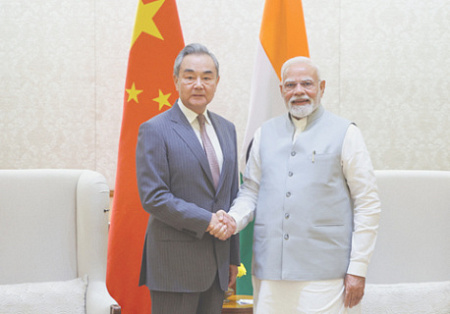
A significant diplomatic overture is underway between Asia’s two giants, as Indian Prime Minister Narendra Modi and visiting Chinese Foreign Minister Wang Yi signal a mutual desire to improve their strained relationship. Following their meeting, Modi emphasized a new phase built on mutual respect and an understanding of each other’s ‘sensitive points.’ This marks a notable shift in tone, coming just years after a deadly, hand-to-hand clash between their soldiers in the Galwan Valley of the Himalayas, a confrontation that brought relations to their lowest point in decades.
While the visit is a crucial step toward normalization, tangible progress remains focused on specific, smaller-scale initiatives. The two nations have agreed to resume direct passenger flights and the issuance of journalist visas, measures aimed at rebuilding people-to-people and media ties that were severed during the period of high tension. However, the fundamental source of friction—the vast, undemarcated border known as the Line of Actual Control—remains unresolved. New Delhi has reiterated its commitment to a ‘fair and mutually acceptable solution,’ but a definitive breakthrough on the border dispute appears distant.
This delicate diplomatic dance is not occurring in a vacuum. The powerful and enduring partnership between China and Pakistan casts a long shadow over any potential Sino-Indian rapprochement. Beijing is Islamabad’s primary military and economic patron, supplying it with advanced weaponry. This strategic alignment deeply complicates India’s security calculations. As one former Indian military commander, Lieutenant General Deependra Singh Hooda, has noted, China’s immense investment in Pakistan means Beijing will almost certainly prioritize its ally over a strategic partnership with New Delhi, India’s arch-rival.
Furthermore, New Delhi’s strategic calculus is heavily influenced by its relationship with the United States. Complications in the India-US partnership, often stemming from Washington’s own dealings with Pakistan, can prompt India to re-evaluate its regional posture. For instance, a past incident where the White House claimed credit for mediating a de-escalation between India and Pakistan was met with a sharp rebuke in New Delhi. This was seen as a challenge to India’s long-standing doctrine of resolving regional disputes bilaterally, a core principle of its foreign policy and a symbol of its status as a major independent power. Such episodes can create distrust and encourage India to seek a more stable, if cautious, relationship with its powerful neighbor.
Ultimately, the renewed dialogue between India and China represents a pragmatic recalibration driven by a complex web of regional rivalries and global power dynamics. While gestures like ministerial visits and resumed flights signal a welcome thaw in a dangerously frozen relationship, the path to a genuine and lasting peace is obstructed by deep-seated strategic mistrust, unresolved territorial claims, and the intricate geopolitical triangle involving Pakistan and the United States.
